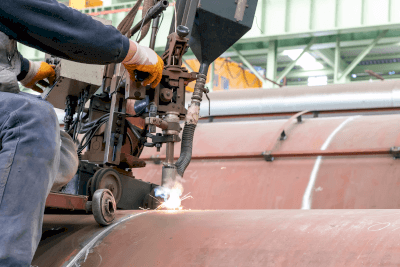What Is a Semi-Automatic Arc Welding Machine?

A semi-automatic arc welding machine is a type of welding machine in which the metal used for welding is supplied automatically.
Normally, when welding metals, work is performed by heating the molten metal necessary for welding with a heating device called a torch to melt it. If this is done manually, both hands are occupied by the hand holding the molten metal and the hand holding the torch, making it difficult to fix the metal to be welded. Therefore, semi-automatic arc welding machines were created to perform only the work of melting the molten metal automatically.
Uses of Semi-Automatic Arc Welding Machines
Semi-automatic arc welding machines are generally used when you want to weld metal to metal. Because the molten metal is fed automatically, welding can be done much faster than with manual welding operations.
However, the disadvantage is that the finish is not as good as manual welding, so it is often used for welding parts that are difficult to see, such as welding truck beds or welding angles and pipes for assembling structures.
Principle of Semi-Automatic Arc Welding Machines
A semi-automatic arc welding machine consists of a torch, a tip device that can melt molten metal, a device that supplies molten metal, and a power source that controls these devices. A switch lever is attached to the torch, and by pressing the lever, an electric current flows, which transfers heat to the metal to be welded or the molten metal to be welded, allowing welding to take place.
The molten metal must not react with oxygen. For this reason, semi-automatic arc welding machines are generally designed to emit a jet of gas from the tip of the welding machine.
The type of semi-automatic arc welding machine also depends on the type of gas to be jetted.
These include CO2 welding, which uses carbon dioxide or other carbon dioxide gas as the shielding gas, MIG welding, which uses argon or helium, and MAG welding, which uses a mixture of 20% carbon dioxide gas and 80% argon gas.
However, because gas welders are susceptible to wind, they must be used indoors.
Types of Semi-automatic Arc Welding Machines
Semi-automatic arc welding machines are available in the following types:
1. CO2 Welding
The advantage of using carbon dioxide is that it is inexpensive, and it is also characterized by its deep penetration and high strength. The finished product is neither good nor bad, but the disadvantage is the high risk of burns due to the large amount of spatter (sparks) produced.
In addition, CO2 cannot be used for welding aluminum or stainless steel because it causes a chemical reaction with nonferrous metals.
2. MIG Welding
Since inert gas is used, spatter is less likely to occur, which has the advantage of achieving a very clean weld surface. In addition, nonferrous metals such as aluminum and stainless steel can only be welded with MIG.
The disadvantages include the high cost of inert gas and the tendency of inert gas to spread the arc, resulting in shallow penetration.
Therefore, the strength is inferior to that of other gas arc welding.
3. MAG Welding
This welding method uses a mixture of inert gas and CO2, which produces less spatter than CO2 and has the advantage of lower running costs compared to MIG.
It is also a method with superior strength due to its deeper melting depth. On the other hand, it has the disadvantage that it cannot be used for welding aluminum and stainless steel because it contains CO2.
Other Information About Semi-automatic Arc Welding Machines
Features of Semi-Automatic Arc Welding Machines
Because the molten wire is fed automatically, even technicians unfamiliar with welding have the advantage of being able to weld relatively easily. In shielded-arc welding, which is a typical manual welding method, the welding rod becomes shorter as it is welded, so it must be fed at a constant speed to the end of the welding point while maintaining the optimum distance from the base metal.
The advantage of semi-automatic arc welding machines is that they automatically maintain the distance from the base metal, so that optimal processing can be achieved by paying attention only to the feed rate.